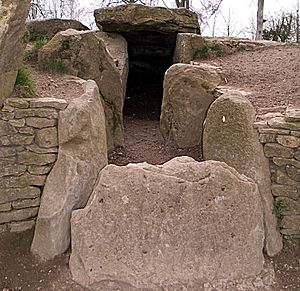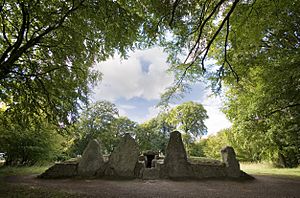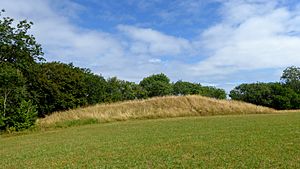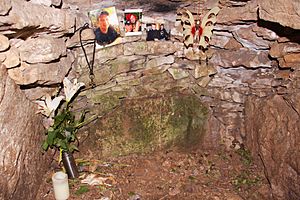Cotswold-Severn Group facts for kids
The Cotswold-Severn Group refers to a special type of ancient burial mounds. These mounds are called long barrows. People built them in western Britain a very long time ago, during the Early Neolithic period. We know of about 200 of these long barrows in the Cotswold-Severn area. Sadly, many others were probably destroyed before anyone could record them.
Contents
What Are These Ancient Mounds?
The idea of the "Cotswold-Severn Group" was first used in 1937 by an archaeologist named Glyn Daniel. These mounds are a specific type of long barrows. Long barrows are a much bigger building style found all over Atlantic Europe. This style reaches from Spain all the way up to Sweden, including the British Isles.
About 40,000 long barrows still exist from the Early Neolithic period across Europe. These long barrows are not the oldest stone buildings in the world. Places like Göbekli Tepe in Turkey are even older. But they are the oldest widespread way that people used stone for building. An archaeologist named Frances Lynch called them "the oldest built structures in Europe" that are still around. Even though they are found in many places, they have different styles in different regions. The Cotswold-Severn Group is one of these regional styles.
The idea for long barrows likely started in what is now Spain, Portugal, and western France. The first ones were built there around 4500 BCE. Then, this building style spread north along the Atlantic coast. It reached Britain by the early 3000s BCE. This was either just after farming arrived or sometimes even before it. The style then moved into other parts of northern Europe. For example, it reached the Netherlands by the late 3000s BCE.
Based on studies, archaeologists believe long barrows appeared quite suddenly in the Cotswolds-Severn region around 3700 BCE. People continued to build them for about 600 years. By 2600 BCE, very few of their inner rooms were still in use. Many had even been purposefully blocked up.
Where Are They Found?
In the Cotswolds-Severn area, we know of about 200 long barrows. We don't know how many were lost before being recorded. At least ten recorded ones have since been destroyed or lost. Over 140 long barrows are found just in the Cotswolds area. In northern Wiltshire and the Dorset chalk hills, the Cotswold-Severn barrows mix with a different style of earth mound. This other style is mostly found in eastern Britain.
Tombs of this type are mostly found in the Cotswolds. But they also reach as far as Gower and Avebury. Some single examples are even found in North Wales. All the different types of these tombs are spread out fairly evenly. Some people think that the design of these tombs changed over time. The Cotswold-Severn tombs are similar to some tombs in France, near the Loire river. They might have been inspired by them. The side rooms and other differences could be local changes.
In the 1960s and 1970s, Dr John X. W. P. Corcoran and others suggested there were actually three different types of these tombs built at the same time. Later studies have shown this to be true.
How Were They Designed?
The places where the Cotswold-Severn long barrows were built were probably chosen very carefully. An archaeologist named Darvill noted that when these sites were new, they looked "brutal and hard." He said they were "bright white rocky mounds covering dark dank shadowy chambers."
What Was Found Inside?
The Cotswold-Severn Group long barrows usually held many human bones. On average, each barrow contained the remains of 40 to 50 people. Sometimes, whole bodies might have been placed inside the chamber and left to decay. Other times, the body might have been prepared outside the barrow. Then, only the bones were placed inside.
Usually, the bones of different people were mixed together in the tomb's chambers. This might have been a way to show that individuals were part of a larger group of ancestors. In some cases, bones were separated into different chambers based on age or gender. Most of the time, bones were added gradually over many years. It also seems that some bones were taken out of the chambers. Perhaps they were used in special ceremonies.
When people entered the chambers to add or remove things, they would have smelled decaying bodies. We don't know if people in the Early Neolithic saw this as a difficult task or an important job.
Sometimes, other items were placed in the chambers with the human bones. These items included pottery, sharp flint tools, small stones, stone discs, beads, bone pins, and dog bones. Most often, cattle bones were found. Animal bones, especially the skulls of cattle and pigs, were also often found in the open areas in front of the barrows. We don't know why these were placed there. They might have been special animals, protective items, or leftovers from feasts.
Archaeological Discoveries
One of the first big studies about these barrows was The Long Barrows of the Cotswolds. It was written by archaeologist O. G. S. Crawford and published in 1925.
During the 1800s and 1900s, some Cotswold-Severn Group sites were fixed up. This was done to make them easier for visitors to see and explore.
List of Sites
In the North Wessex Downs
| Name | Location | Listed number | Still extant |
|---|---|---|---|
| Beckhampton Firs Long Barrow | |||
| East Kennett Long Barrow | East Kennett, Wiltshire | 1012323 | |
| Horton Down Long Barrow | Wiltshire | 1013141 | |
| Kitchen Barrow | Wiltshire | 1012519 | |
| Longstones Long Barrow | Wiltshire | 1008126 | |
| Shepherd's Shore | Wiltshire | 1014030 | |
| South Street Long Barrow | Wiltshire | ||
| Wayland's Smithy | Oxfordshire | 1008409 | |
| West Kennet Long Barrow | Wiltshire | 1010628 | |
| West Woods Long Barrow | Wiltshire |
In the Cotswold Hills
| Name | Location | Listed number | Still extant |
|---|---|---|---|
| Avening Long Barrow | Avening, Gloucestershire | No | |
| Belas Knap | Sudeley, Gloucestershire | 1008199 | Yes |
| Bown Hill Long Barrow | Gloucestershire | 1017085 | |
| Boxwell Lodge | Gloucestershire | ||
| Buckholt Wood Long Barrow | Near Nympsfield, Gloucestershire | ||
| Coberley Long Barrow | Gloucestershire | 1002129 | |
| Fox Covert Long Barrow | Wiltshire | 1010396 | |
| Gatcombe Lodge Long Barrow | Gloucestershire | 1008623 | |
| Giant's Cave | Near Badminton, Wiltshire | 1010394 | |
| Hawkesbury Knoll Long Barrow | Hawkesbury, Gloucestershire | ||
| Lanhill Long Barrow | Wiltshire | 1010908 | |
| Lechmore Tump | Gloucestershire | 1002114 | |
| Leighterton Long Barrow | Leighterton, Gloucestershire | 1013590 | |
| Lineover Long Barrow | Gloucestershire | 1018166 | |
| Lugbury Long Barrow | Wiltshire | 1010397 | |
| Uley Long Barrow | Uley, Gloucestershire | 1008195 | Yes |
| Norn's Tump | Gloucestershire | 1008196 | |
| Notgrove Long Barrow | Notgrove, Gloucestershire | 1009157 | |
| Nympsfield Long Barrow | Frocester, Gloucestershire | 1007912 | |
| Starveall Long Barrow | Gloucestershire | 1002473 | |
| Stoney Littleton Long Barrow | Somerset | 1007910 | |
| Symonds Hall Long Barrow | Near Wotton-Under-Edge, Gloucestershire | 1002113 | |
| The Tingle Stone | Gloucestershire | 1008622 | |
| The Toots | Near Selsey, Gloucestershire | 1002131 | |
| Tormarton Long Barrow | Near Tormarton, Gloucestershire | ||
| Randwick Long Barrow | Gloucestershire | 1002107 | |
| Whispering Knights | Oxfordshire | 1018400 | |
| Whitfield's Tump | Near Minchinhampton, Gloucestershire | 1008092 | |
| Windmill Tump Long Barrow | Rodmarton, Gloucestershire | 1008198 | |
| Woodleaze Farm Long Barrow | Near Kingscote, Gloucestershire |
West of the Severn
| Name | Location | Listed number | Still extant |
|---|---|---|---|
| Arthur's Stone | Bredwardine, Herefordshire | 1010720 | |
| Cross Lodge Long Barrow | Herefordshire | 1014106 | |
| Gwernvale Long Barrow | Crickhowell, Powys | ||
| Parc le Breos Cwm | Pem-maen, Swansea | ||
| Maesyfelin Long Barrow | St Lythans, Vale of Glamorgan | ||
| Tinkinswood | St Nicholas, Vale of Glamorgan |
Images for kids






